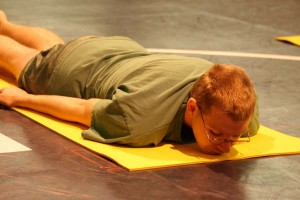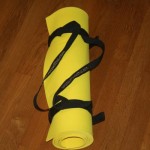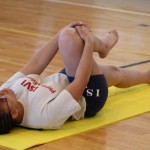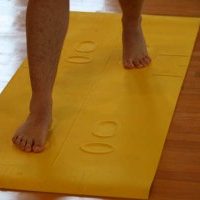Shipping Notes
Canadian Customers: We do not charge import duty, so you will be responsible for those fees on receipt.
VIYM® is designed to enable those who are blind, partially blind or who may face physical challenges due to age or disability to practice yoga safely and confidently.
The mats can be used by young people and adults in physical education classes, in rehabilitation facilities, community centers, at home or in a yoga studio. Thicker than a traditional mat, they can still be rolled or loosely folded to transport to school, a studio or stored at home.
 They are easily transportable, coming with their own handy carrying strap, or a specially designed VIYM® carrying bag can be purchased (see below).
They are easily transportable, coming with their own handy carrying strap, or a specially designed VIYM® carrying bag can be purchased (see below).
VIYM® is designed in three dimensions, with raised and depressed features called ''stations'' strategically placed to help the challenged yoga student feel where their hands, feet and head should be placed for all 24 basic yoga postures.
These intuitive tactile feedback features also help him/her to feel their location and direction on the mat, helping the student to obtain the all important body alignment during a yoga posture sequence. It is ¼" thick, 68 inches long and 24 inches wide.
 Each VIYM® comes with its own carrying strap and you can order replacement straps later, in case you lose the one that ships with your mat.
Each VIYM® comes with its own carrying strap and you can order replacement straps later, in case you lose the one that ships with your mat.
Designed for the average sized person (5' 3" or taller), the VIYM® easily accommodates those shorter or taller who need only to adjust their stride for a comfortable fit.
 Prior to VIYM®, visually or physically challenged aspiring yoga students faced some discouraging challenges. They often had trouble detecting the location of their body and the direction in which they were facing on a mat. Balancing in yoga postures was awkward: students had a hard time sensing and reaching optimal, ideal body alignment without any visual cues.
Prior to VIYM®, visually or physically challenged aspiring yoga students faced some discouraging challenges. They often had trouble detecting the location of their body and the direction in which they were facing on a mat. Balancing in yoga postures was awkward: students had a hard time sensing and reaching optimal, ideal body alignment without any visual cues.
Instructors faced similar challenges as they tried to articulate posture instructions or give body directions in ways that made sense without any eye contact or visual cues.

